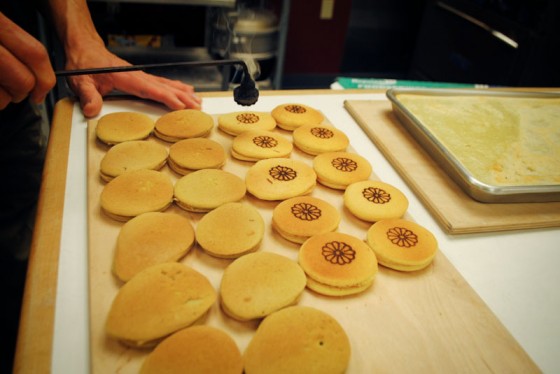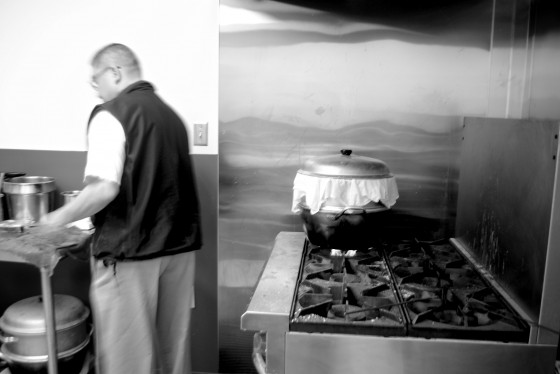Art Oki, mastermind of Umai-Do Japanese sweet shop, brings the nostalgic taste of manju home for the holiday season.
As many Americans re-visit the mainstream traditions of Christmas and New Year’s (Love Actually/ham/gym memberships) some cultural communities around Seattle are making other plans. As always, food is central.
But these edible traditions are more than just a thing for adventure-seeking foodies to fawn over. Food is a marker of change, a preserver of culture, and above all, the best storyteller.
On Christmas, hundreds of Jews like my family gather for the holy ritual of seeing a movie and going out for Chinese food. Ironically, what started as an attempt by Eastern European immigrants to shrink behind old world ways and appear more ‘American’, has now become the opposite — an assertion of Jewishness at a time when American Jews have become as white as Christians.
Vietnamese-American Catholics like my friend Teresa Dang have a not-so-traditional réveillon meal following midnight mass on Christmas eve, featuring rice congee (cháo) instead of wine and bûche de Noël. The meal is a reflection of the evolution of Vietnamese, and French colonial influences behind her family’s story.
In the wee hours of last Wednesday morning, Art Oki described his own relationship to manju, a traditional Japanese dessert crafted in his shop, Umai-Do which means ‘delicious way’. Indeed, it is.
 Art Oki meticulously prepares dorayaki, a cake-flour dessert with red bean paste, branded with an emblematic chrysanthemum. (Photo by Anna Goren)
Art Oki meticulously prepares dorayaki, a cake-flour dessert with red bean paste, branded with an emblematic chrysanthemum. (Photo by Anna Goren)
The rice and cake-flour dumplings are ubiquitous in Japan, and mochi — a traditional confection sold at Umai-Do — is also eaten as a part of the Japanese New Year’s meal. Historically, mochi was made by pounding large quantities of rice flour by hand with a wooden mallet until it changed consistency into a glutinous, putty-like delicacy.
The sheer laboriousness of the process elevated mochi into something worthy of special occasions, like New Year’s. Oki uses a machine so he could churn the stuff out, which is ideal for people like me, who could toss back the stuff for three meals a day. Traditional mochi-making will take place in celebrations throughout the region throughout the first week of January.
Despite Seattle’s impressive Japanese community, we have been missing a true Japanese sweets shop, like the one Oki remembers visiting as a child, for too long. The first shop in the International District, Sagamiya, closed in the 1970’s when the children of the owners decided to opt out of the dessert business for more lucrative jobs. Today, Umai-Do joins Tokara in Phinney Ridge as the only locally made manju.
“The [New Years] meal goes on forever — it’s spread out over days”, said Oki, who explained the importance of each ceremonial dish and its association with a new wish for the year. In his family the mochi, which is prepared differently on New Year’s in different regions of Japan, is pan-fried and added to a soup called zoni — the most auspicious of the dishes.
Oki, a true Seattleite, grew up in Beacon Hill and attended Franklin High School, and went on to have a long career with the City of Seattle as an accountant. Seven years ago, just for the thrill of it, he began apprenticing during the summers at the closest manju bakery he knew of, in California.
He would travel back to Seattle with confections in his carry-ons for friends and family who were nostalgic for the iconic sweet they grew up on.
He says his own creations started off lumpy, but slowly learned the repetitive art of shaping, filling, and branding the manju so that each piece came ever closer to the perfection that he strove for.
Perhaps selfishly, friends convinced Oki to open his own shop a year and a half ago. He chose the building on 18th and Jackson for its roots — a beloved Asian-American eatery called “300 Restaurant” used to be in the same building.
But the fate of his current store is indicative of the rapid changes occurring in central Seattle. Oki will have to relocate within the next 14 months, as the building is slated to be demolished and replaced with a larger residential and commercial development.
Oki’s clientele is a mix of longtime manju–lovers who come for the traditional sweet bean paste-filled dumplings of their childhood, and younger folks from the neighborhood, many of whom are eating manju for the first time.
Both are wooed by the sticky, cloud-like texture and delicate flavor of the silky bean paste inside. Oki also offers creative variations like the imogashi, a cinnamon-dusted cake roll that Oki compared to a snickerdoodle, or a dark chocolate-filled mochi made special for the holidays.
 Art Oki begins the process of preparing traditional New Years mochi by steaming the mochigome, a short-grain glutinous rice. (Photo by Anna Goren)
Art Oki begins the process of preparing traditional New Years mochi by steaming the mochigome, a short-grain glutinous rice. (Photo by Anna Goren)
“I had this Hawaiian guy calling me so excited, that he hasn’t seen some of these since he was a kid,” said Oki, who brought back the chi-chi dango, a version made with coconut milk by Japanese living on the island. “He said it tasted just like home.”
For those without a historic attachment to mochi, there are other benefits to the simplicity of the desserts, which are mostly gluten and dairy-free, relatively low in sugar and high in protein.
“Someone told me I should see about making these kosher so that Jewish people could eat them too — why not?” Oki quips.
Oki’s manju-making process is both zen-like and surgical, combining the creativity of a shokunin, or craftsman, and the technical knowledge of a baker. He is able to magically transfer skills from a former life in public finance to the niche industry of specialty desserts: attention to detail, stamina for repetition, and a desire for perfection are crucial to his 700 year old craft. Still, he made clear that unlike his competitor, Tokara, his stuff is “for the commoner.”
“Sometimes you see manju that look so beautiful that you don’t want to eat it,” he smiled.“This is to eat.”
It is also for celebrating. At Umai-Do, orders have already begun to pour in for New Years mochi, for a meal traditionally spent with family expressing wishes of health, luck, and success over a never-ending stream of specialty dishes.
With that lineup, it will be hard for 2014 to go wrong.
Umai Do is located at 1825 S. Jackson Street. Oki will be selling pounded mochi through January 3rd for the New Years Holiday. A traditional New Year’s celebration with mochi-making will be held on January 5th at Islandwood on Bainbridge Island, hosted by BIJAC.
[ts_fab authorid=”41″ tabs=”bio”]
[ts_fab authorid=”204″ tabs=”bio”]


Oh, these look so good! I wish this place had existed last time I was in Seattle!